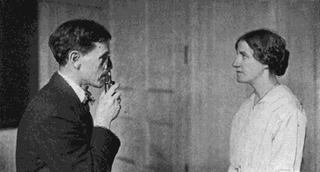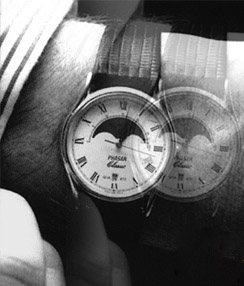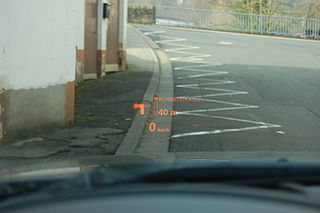Related Research Articles

A saccade is a quick, simultaneous movement of both eyes between two or more phases of fixation in the same direction. In contrast, in smooth-pursuit movements, the eyes move smoothly instead of in jumps. The phenomenon can be associated with a shift in frequency of an emitted signal or a movement of a body part or device. Controlled cortically by the frontal eye fields (FEF), or subcortically by the superior colliculus, saccades serve as a mechanism for fixation, rapid eye movement, and the fast phase of optokinetic nystagmus. The word appears to have been coined in the 1880s by French ophthalmologist Émile Javal, who used a mirror on one side of a page to observe eye movement in silent reading, and found that it involves a succession of discontinuous individual movements.

Tunnel vision is the loss of peripheral vision with retention of central vision, resulting in a constricted circular tunnel-like field of vision.

The Bates method is an ineffective and potentially dangerous alternative therapy aimed at improving eyesight. Eye-care physician William Horatio Bates (1860–1931) held the erroneous belief that the extraocular muscles effected changes in focus and that "mental strain" caused abnormal action of these muscles; hence he believed that relieving such "strain" would cure defective vision. In 1952, optometry professor Elwin Marg wrote of Bates, "Most of his claims and almost all of his theories have been considered false by practically all visual scientists."

Strafing is the military practice of attacking ground targets from low-flying aircraft using aircraft-mounted automatic weapons. Less commonly, the term is used by extension to describe high-speed firing runs by any land or naval craft such as fast boats, using smaller-caliber weapons and targeting stationary or slowly-moving targets.

Weapon focus is the concentration on a weapon by a witness of a crime and the subsequent inability to accurately remember other details of the crime. Weapon focus is a factor that heavily affects the reliability of eyewitness testimony. This effect involves a witness to a crime diverting his or her attention to the weapon the perpetrator is holding, thus causing memory impairments and leaving less attention for other details in the scene, such as the attacker’s face, clothing or vehicle.

A scotoma is an area of partial alteration in the field of vision consisting of a partially diminished or entirely degenerated visual acuity that is surrounded by a field of normal – or relatively well-preserved – vision.

Road rage is aggressive or angry behavior exhibited by motorists. These behaviors include rude and verbal insults, yelling, physical threats or dangerous driving methods targeted at other drivers, pedestrians or cyclists in an effort to intimidate or release frustration. Road rage can lead to altercations, damage to property, assaults, and collisions that result in serious physical injuries or even death. Strategies include cutting motorists off, inappropriate honking, using obscene gestures, flipping off another driver, swerving, tailgating, brake checking, and attempting to fight.
The visual field is "that portion of space in which objects are visible at the same moment during steady fixation of the gaze in one direction"; in ophthalmology and neurology the emphasis is on the structure inside the visual field and it is then considered “the field of functional capacity obtained and recorded by means of perimetry”.

Diplopia is the simultaneous perception of two images of a single object that may be displaced horizontally or vertically in relation to each other. Also called double vision, it is a loss of visual focus under regular conditions, and is often voluntary. However, when occurring involuntarily, it results in impaired function of the extraocular muscles, where both eyes are still functional, but they cannot turn to target the desired object. Problems with these muscles may be due to mechanical problems, disorders of the neuromuscular junction, disorders of the cranial nerves that innervate the muscles, and occasionally disorders involving the supranuclear oculomotor pathways or ingestion of toxins.
The autokinetic effect is a phenomenon of visual perception in which a stationary, small point of light in an otherwise dark or featureless environment appears to move. It was first recorded in 1799 by Alexander von Humboldt who observed illusory movement of a star in a dark sky, although he believed the movement was real. It is presumed to occur because motion perception is always relative to some reference point, and in darkness or in a featureless environment there is no reference point, so the position of the single point is undefined. The direction of the movements does not appear to be correlated with involuntary eye movements, but may be determined by errors between eye position and that specified by efference copy of the movement signals sent to the extraocular muscles. Richard Gregory suggested that, with lack of peripheral information, eye movements which correct movements due to muscle fatigue are wrongly interpreted as movement of the perceived light.
Eye tracking is the process of measuring either the point of gaze or the motion of an eye relative to the head. An eye tracker is a device for measuring eye positions and eye movement. Eye trackers are used in research on the visual system, in psychology, in psycholinguistics, marketing, as an input device for human-computer interaction, and in product design. In addition, eye trackers are increasingly being used for assistive and rehabilitative applications such as controlling wheelchairs, robotic arms, and prostheses. Recently, eye tracking has been examined as a tool for the early detection of autism spectrum disorder. There are several methods for measuring eye movement, with the most popular variant using video images to extract eye position. Other methods use search coils or are based on the electrooculogram.
Inattentional blindness or perceptual blindness occurs when an individual fails to perceive an unexpected stimulus in plain sight, purely as a result of a lack of attention rather than any vision defects or deficits. When it becomes impossible to attend to all the stimuli in a given situation, a temporary "blindness" effect can occur, as individuals fail to see unexpected but often salient objects or stimuli.
Stereopsis is the component of depth perception retrieved through binocular vision. Stereopsis is not the only contributor to depth perception, but it is a major one. Binocular vision happens because each eye receives a different image because they are in slightly different positions in one's head. These positional differences are referred to as "horizontal disparities" or, more generally, "binocular disparities". Disparities are processed in the visual cortex of the brain to yield depth perception. While binocular disparities are naturally present when viewing a real three-dimensional scene with two eyes, they can also be simulated by artificially presenting two different images separately to each eye using a method called stereoscopy. The perception of depth in such cases is also referred to as "stereoscopic depth".
Closed-eye hallucinations and closed-eye visualizations (CEV) are hallucinations that occur when one's eyes are closed or when one is in a darkened room. They should not be confused with phosphenes, perceived light and shapes when pressure is applied to the eye's retina, or some other non-visual external cause stimulates the eye. Some people report CEV under the influence of psychedelics; these are reportedly of a different nature than the "open-eye" hallucinations of the same compounds. Similar hallucinations that occur due to loss of vision are called "visual release hallucinations".
A cover test or cover-uncover test is an objective determination of the presence and amount of ocular deviation. It is typically performed by orthoptists, ophthalmologists and optometrists during eye examinations.
Bracketing means looking at a situation and refraining from judgement and bias opinions to wholly understand an experience. The preliminary step in the philosophical movement of phenomenology is describing an act of suspending judgment about the natural world to instead focus on analysis of experience. Suspending judgement involves stripping away every connotation and assumption made about an object. Its earliest conception can be traced back to Immanuel Kant who argued that the only reality that one can know is the one each individual experiences in their mind . Edmund Husserl, building on Kant’s ideas, first proposed bracketing in 1913, to help better understand another’s phenomena.
Strafing in video games is a maneuver which involves moving a controlled character or entity sideways relative to the direction it is facing. This may be done for a variety of reasons, depending on the type of game; for example, in a first-person shooter, strafing would allow one to continue tracking and firing at an opponent while moving in another direction.
Chronostasis is a type of temporal illusion in which the first impression following the introduction of a new event or task-demand to the brain can appear to be extended in time. For example, chronostasis temporarily occurs when fixating on a target stimulus, immediately following a saccade. This elicits an overestimation in the temporal duration for which that target stimulus was perceived. This effect can extend apparent durations by up to half a second and is consistent with the idea that the visual system models events prior to perception.

An automotive head-up display or automotive heads-up display — also known as an auto-HUD — is any transparent display that presents data in the automobile without requiring users to look away from their usual viewpoints. The origin of the name stems from a pilot being able to view information with the head positioned "up" and looking forward, instead of angled down looking at lower instruments. At this time, there are three different approaches to OEM HUDs in automobiles. The first is to treat the back of the windshield in such a way that an image projected onto it will reflect to the driver. The second is to have a small combiner that is separate from the windshield. Combiners can be retracted. The third is to laminate a transparent display in between layers of the windshield glass.

Motion silencing is an illusion or perceptual phenomenon in which objects that are rapidly changing in a particular salient property seem to cease changing with motion. The illusion was first identified by Jordan Suchow and George Alvarez in the publication of their research on the topic.
References
- 1 2 Edmunds, Glen. "The Phenomenon of Target Fixation & How To Avoid It". Glen Edmunds Performance Driving School. Archived from the original on April 13, 2014. Retrieved 12 April 2014.
- ↑ Colgan, William B. (2010), Allied Strafing in World War II: A Cockpit View of Air to Ground Battle, McFarland, ISBN 978-0-7864-4887-6
- 1 2 "Do You Have "Eyes on the Prize" or "Target Fixation"?". Psychology Today. Retrieved 2020-04-08.
- ↑ "Safety Check | Target Fixation". United States Parachute Association. Retrieved 2020-04-08.
- 1 2 "How to Avoid Target Fixation | Riding Skills Series". Cycle World. Retrieved 2020-04-08.